dotd-2010-03-07 draft
 lordmarcovan
Posts: 43,658 ✭✭✭✭✭
lordmarcovan
Posts: 43,658 ✭✭✭✭✭
DIGS O' THE DAY (2010-03-07): A MILE DOWN BLADEN ROAD
We'd just returned from an overnight trip down to Jacksonville, Florida, and the afternoon found me a little tired and sleepy. I knew I'd only end up napping if I stayed around the house, so I decided to initiate my "walk a mile a day" plan. As mentioned in the previous story, I've gotten really out of shape and I'll be needing to start exercising more and shedding a few pounds before my week-long digging expedition to England in the fall, if that ends up happening. (As of this writing, my friends and readers have put up quite a lot of support to send me on the trip- over 43 contributors have pledged 123 shares totaling $1,865 so far, so it looks as though the trip is becoming a very real possibility!)
I wasn't up to a detector outing on this particular afternoon, since my knees took a week from to recover from the last outing, and I still haven't bought knee pads. So today was mostly just for the sake of exercise more than digging.
Still, I knew of a place quite close to home where I could combine a little low-tech, easy treasure hunting with a mile-long walk. Not a detector search, but something simpler... a fossil hunt.
The required tools for a hunt like this come as standard equipment on most human bodies. Nothing but feet, eyes, and hands- that's it! My optional tool is just a long wooden stake for poking and flipping stuff out of the sand without having to bend and stoop constantly. Today I also brought along an old drywall hammer that has a small hatchet on one end, to act as a rock hammer for chiseling stuff out of the hardpan. In our dirt roads during dry weather, the compressed earth gets really hard-packed and baked to the consistency of brick. Of course I also brought along my wife's digital camera to document the outing.
The site I chose for my mile-long walk is Bladen Road, in the western portion of Glynn County, Georgia, quite near our rural home. I figured it would be the perfect place to combine walking with fossil hunting, and possibly some wildlife photography as well. One of my birdwatching goals is to see the brightly-colored painted bunting. They've been spotted around the marshes on barrier islands here, but I've never had the honor of meeting one. If and when I ever do, I sure hope I have a camera on hand. With me on foot out in the middle of nowhere on a desolate country road, there is no telling what sorts of birds and wildlife I might see.
If you're wondering how a road like this can be a source of fossils, it's because our county obviously uses dredge spoil material to fill in and resurface the dirt roads out here. This dredge spoil is basically sand, pumped up from the bottom of local waterways like the Atlantic shipping channel, Saint Simons Sound, and Brunswick Harbor. It's full of fossils, including a good number of shark teeth. The shark tooth is Georgia's state fossil.
One of last year's unwritten outings was a stroll down Bladen Road, and I found half of a large megalodon tooth. The fossilized teeth of C. megalodon, the extinct giant white shark, are the prize fossils of this area and the biggest shark teeth known. This partial megalodon fossil was buried in the hardpan soil of the roadbed with only a little bit of the root peeking out, and I'd had to chisel it out with the tire tool from the car. These fossils are relatively uncommon finds and are always exciting when they turn up.
Later that same afternoon, down at the boat ramp near our house (the road to which is also surfaced with dredge sand), I was with my daughter Victoria, and she found her first shark tooth. She'd seen some telltale black material in the whitish sand, and asked me to dig it out for her. Was it the typical small tooth of some more common species? No! It was a mostly-intact Megalodon, about four inches long! Wow, talk about beginner's luck! That was quite a memorable afternoon, with father and daughter both scoring megalodons in the space of about an hour.
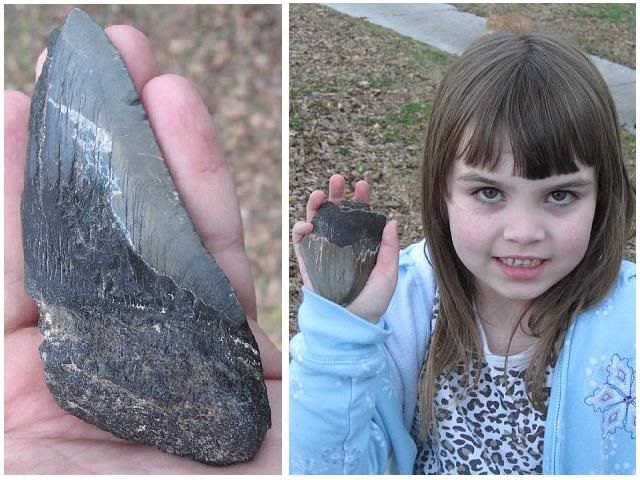
My half tooth, at about four and a half inches, was the larger of the two, but hers was more intact, being a whole tooth with just the corners of the root broken off. These bigger teeth tend to suffer some damage when they come up through the dredge, so fully intact ones are truly rare and special finds. Even partial ones are exciting enough for us. Most of the really impressive intact specimens are found by "black water" divers, who grope along the bottom in murky water and find them by touch. That doesn't sound like a lot of fun to me, so I'm grateful to have the opportunity to hunt these fascinating fossils on dry land.
Victoria wasn't in the mood to join me this afternoon when she was told I'd be walking a mile and would be out there a while. She went next door to play with the neighbor's daughter. I told my wife where I was headed, and set out on the day's adventure.
The road stretched out for miles through the piney woods, with nothing but thickets on either side for most of its length. Occasionally it was criscrossed by other, narrower tracks, which are no doubt used by the paper companies who harvest the trees, or hunters who lease the land. I passed a pair of pickup trucks on my way in, and the men in them released some baying hounds into the woods. I'm a hunter of coins, relics, and fossils rather than wild animals, so I don't really keep abreast of the hunting season, though I suppose I should, for safety's sake. I'm not sure what the hounds were after. Deer? Raccoon? Wild hogs? We have all of those. I heard gunshots in the far distance, though these men didn't guns in hand. They got back into their trucks and took off down the road behind me, leaving their dogs in the woods to chase whatever quarry had been flushed out. I guess they would meet up with the dogs further back down the road, in the direction I'd come from.
I drove on a couple more miles to give the hunters a wide berth. My plan was to find two crossroads that were about a half mile apart, pull the car over onto one of them, walk to the other, and then back, making a mile's hike in total. If I could walk a mile a day, maybe I'd have a few less pounds on my body and a few more fossils in my pocket.
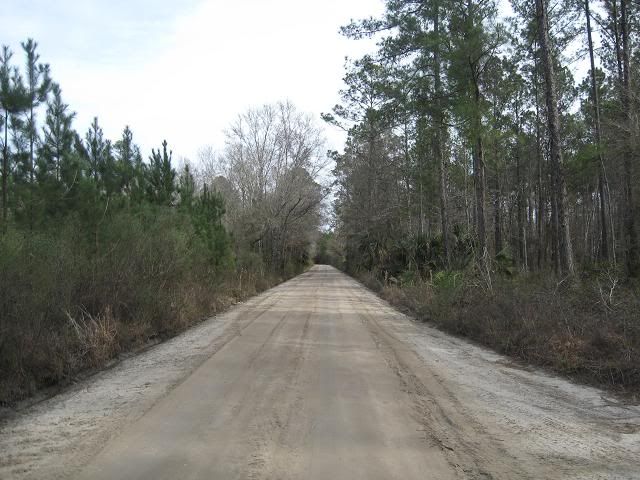
After parking my car at a crossroad and beginning the walk, I immediately noticed many small bits of white seashell fragments in the dirt road. This was a sure sign of dredge sand. The next thing I looked for was the telltale black of fossilized material, or the triangular shape of fossil shark teeth, which can be either black or grey, and are usually a bit glossier than the bits of shell.
It wasn't long before I noticed the shape of a shark tooth in the dirt. It wasn't a big megalodon, but those are rare finds, after all. This was a smaller tooth, but obviously a tooth. The enamel on it was grey and it had tiny serrations along one edge. I'm not sure what species of shark it came from- when it comes to fossils, I'm no paleontologist but rather a pure amateur. I've learned how to distinguish a few types, but that's about all. This tooth, like the four-and-a-half inch Meg I'd found last year near the same stretch of road, was split in two vertically from root to point. It was no great prize, but a step in the right direction. I photographed it where it lay.
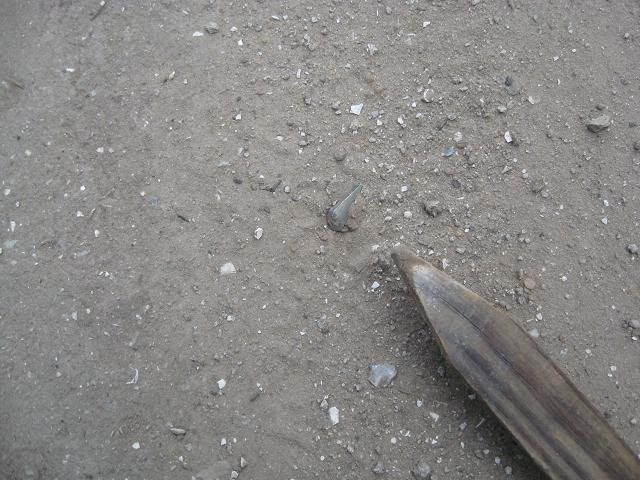
I was soon spotting other bits of black fossilized material in the sand. Most of these proved to be bits of whalebone. I've heard that whales were the primary food source for prehistoric sharks like megalodon, and usually where there's fossilized whalebone, there are shark teeth. This whalebone is such a common find on these sites that we don't always pick it up anymore. Still, because the unenameled root and core portions of a big megalodon tooth are black and porous-looking, just like fossil whalebone is, I usually try to pop all black fossil pieces out of the ground to make sure they aren't part of a buried Meg. The whalebone tends to be in narrow pieces, with striations like woodgrain along it. I spotted a piece of black fossil material and found it impossible to pry out, so I had to resort to the drywall hammer. As I'd thought, it proved to be a small piece of whalebone.

The next piece of fossilized material had a knoblike shape on one side, and sort of a porous look on the other. I have no idea what it is. I've read about gastroliths, which are stones that had been ingested by prehistoric creatures, perhaps to aid digestion or act as "ballast". Some gastroliths looked a bit like this, but I believe those started out as actual stones, rather than becoming petrified by fossilization. Maybe this was the knobbed end of a bone that fit into a ball-and-socket type joint? I have no idea. Fossils from both marine and land animals can be found in this dredge spoil, since the coastline fluctuated over millions of years.
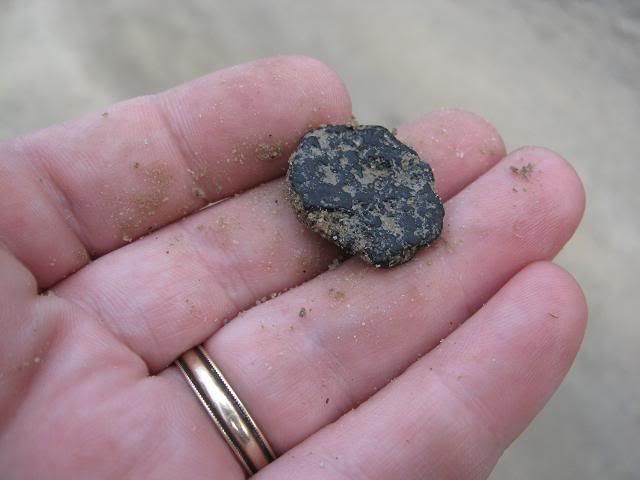
The new season's mosquitoes are out, now. They were flying around me, though they apparently hadn't fully developed their bloodlust yet. I was thankful for that. They mostly just swarmed around, never landing to take a bite. Only once did I get my ear buzzed. I am sure it won't be long before they become really aggressive.
Surprisingly, I saw no birds or animals. I thought my quieter approach on foot would give me better opportunity to see some wildlife. Apparently they saw, heard, or smelled me coming well in advance, though, and made themselves scarce. Only a faint whirring of insects in the thicket announced the presence of any living creatures besides myself and the mosquitoes. Maybe I actually have a better chance of seeing them in the car, because though that method of approach is much louder, the added speed gives the critters less of a chance to beat it into the woods without being seen.
Finally there was a subdued crashing sound in the thicket, indicating that I'd startled some small animal or large bird. I never saw what made the noise, though. It was long gone into the dense underbrush. It didn't sound big enough to be a deer. Speaking of which, some tracks nearby indicated that deer had been here. They'd probably come to the side of the road to drink from the drainage ditch. They're a very common sight in this area.
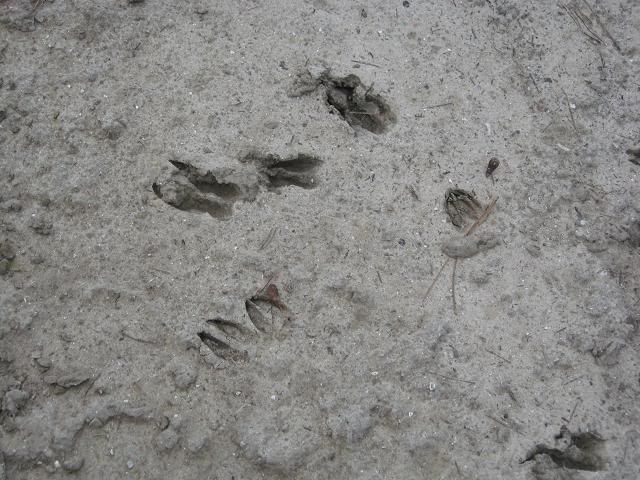
I reached the second crossroad, half a mile from my car, and turned back, walking on the opposite side of the road and also watching the looser sand along the shoulders for fossils. Soon I pried out another bit of fossil material and found another round, knoblike thing, very much like the first "mystery fossil" but a little bit larger this time. I was no closer to having any idea what they were, though.
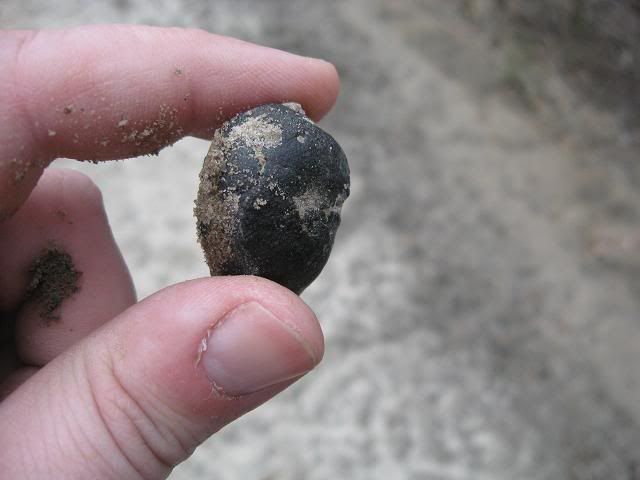
I returned to the first crossroad and my car, having broken a light sweat since I'd worn a jacket and the temperature was probably near seventy. One mile walked. It wasn't so bad. I doubt I could have jogged it, but maybe if I can make myself walk a mile a day, I'll be in a bit better shape. Surely it can't hurt. My appetite for walking was spent but I still wanted to find a good fossil, so I decided to stop by the boat ramp on my way home, where Victoria had found her Meg last year.
As I rumbled down the washboard road, I saw a Jeep Cherokee approaching and moved over to let it pass. As it did, I noticed it was Heather, the lady who lives next door to us. She is the same neighbor whose daughter Victoria had gone to play with. I thought it strange to be passing her out here in the middle of nowhere. She stopped and was backing up, so I did the same, bringing our driver's side windows up next to one another.
"What are you doing out here, in the middle of nowhere?" I asked.
"Looking for you," she replied.
I thought she was kidding for a moment, until I saw her face. It was serious, and even a little worried.
"What?"
"Victoria fell off the swing set and broke her arm. Lenee tried to reach you on your cell phone but couldn't get through, so she sent me out to look for you. They've gone on to the immediate care center."
I blurted out a profanity, failing to notice that Heather's daughter, Victoria's playmate, was in the passenger seat. I apologized.
I had brought my cell phone out with me, but hadn't turned it on. I seldom do, unless I need to make an outgoing call. I turned it on and attempted to call my wife, Lenee, but got no signal. Heather and her daughter drove on, and I raced down what remained of Bladen Road, all the while trying to get a signal on the phone. About the time I reached the southern terminus of the road, where it becomes paved, I got enough of a signal to call, and was told by my wife that the immediate care had sent them on to the emergency room.
When I arrived at the hospital, wife and daughter were both much calmer than I'd expected. We'd gone through a similar ordeal a while back, when Victoria got kicked hard in the forehead by her pony. That one was more serious. This time, thanks to pain medication, she was relaxed and actually smiled at me when I came in.
She had done a backflip off the swing, landing on her face and hands, getting a mouthful of dirt and breaking the radius bone in her left arm, near the wrist. She took the whole procedure at the hospital well, I must say. Better than I would have done, at her age. (Or even twice her age.) She was actually concerned that she'd miss school the next day! It turns out that her teacher, who recently had a baby, was coming back to the school to visit and show off the newborn. Not even a broken arm could keep Victoria from seeing her teacher and that baby! (It didn't, either- though she was out of school the following day, I did bring her in for an hour so she could see the baby and show off her cast to the class.)
So like the last outing when my car blew up, this one ended in disaster, but nothing permanent, thank goodness.
It wasn't the most productive of outings, but at least I got out. I had my one-mile walk in the woods, and found five fossils: one partial shark tooth, two pieces of whalebone, and the two rounded "mystery fossils". The day wasn't a total waste.
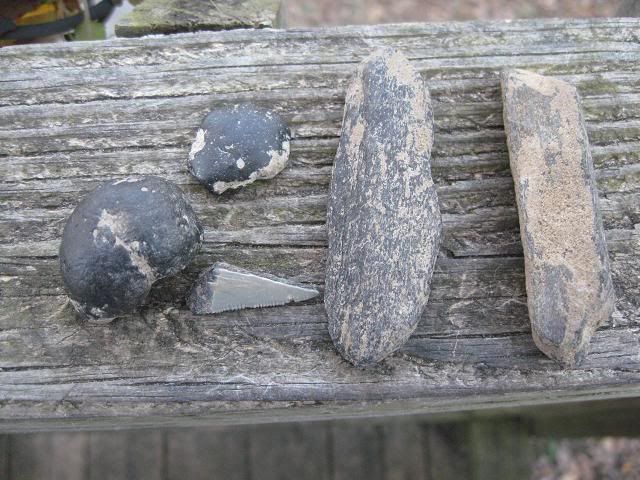
~RWS
INDEX OF DIG STORIES
We'd just returned from an overnight trip down to Jacksonville, Florida, and the afternoon found me a little tired and sleepy. I knew I'd only end up napping if I stayed around the house, so I decided to initiate my "walk a mile a day" plan. As mentioned in the previous story, I've gotten really out of shape and I'll be needing to start exercising more and shedding a few pounds before my week-long digging expedition to England in the fall, if that ends up happening. (As of this writing, my friends and readers have put up quite a lot of support to send me on the trip- over 43 contributors have pledged 123 shares totaling $1,865 so far, so it looks as though the trip is becoming a very real possibility!)
I wasn't up to a detector outing on this particular afternoon, since my knees took a week from to recover from the last outing, and I still haven't bought knee pads. So today was mostly just for the sake of exercise more than digging.
Still, I knew of a place quite close to home where I could combine a little low-tech, easy treasure hunting with a mile-long walk. Not a detector search, but something simpler... a fossil hunt.
The required tools for a hunt like this come as standard equipment on most human bodies. Nothing but feet, eyes, and hands- that's it! My optional tool is just a long wooden stake for poking and flipping stuff out of the sand without having to bend and stoop constantly. Today I also brought along an old drywall hammer that has a small hatchet on one end, to act as a rock hammer for chiseling stuff out of the hardpan. In our dirt roads during dry weather, the compressed earth gets really hard-packed and baked to the consistency of brick. Of course I also brought along my wife's digital camera to document the outing.
The site I chose for my mile-long walk is Bladen Road, in the western portion of Glynn County, Georgia, quite near our rural home. I figured it would be the perfect place to combine walking with fossil hunting, and possibly some wildlife photography as well. One of my birdwatching goals is to see the brightly-colored painted bunting. They've been spotted around the marshes on barrier islands here, but I've never had the honor of meeting one. If and when I ever do, I sure hope I have a camera on hand. With me on foot out in the middle of nowhere on a desolate country road, there is no telling what sorts of birds and wildlife I might see.
If you're wondering how a road like this can be a source of fossils, it's because our county obviously uses dredge spoil material to fill in and resurface the dirt roads out here. This dredge spoil is basically sand, pumped up from the bottom of local waterways like the Atlantic shipping channel, Saint Simons Sound, and Brunswick Harbor. It's full of fossils, including a good number of shark teeth. The shark tooth is Georgia's state fossil.
One of last year's unwritten outings was a stroll down Bladen Road, and I found half of a large megalodon tooth. The fossilized teeth of C. megalodon, the extinct giant white shark, are the prize fossils of this area and the biggest shark teeth known. This partial megalodon fossil was buried in the hardpan soil of the roadbed with only a little bit of the root peeking out, and I'd had to chisel it out with the tire tool from the car. These fossils are relatively uncommon finds and are always exciting when they turn up.
Later that same afternoon, down at the boat ramp near our house (the road to which is also surfaced with dredge sand), I was with my daughter Victoria, and she found her first shark tooth. She'd seen some telltale black material in the whitish sand, and asked me to dig it out for her. Was it the typical small tooth of some more common species? No! It was a mostly-intact Megalodon, about four inches long! Wow, talk about beginner's luck! That was quite a memorable afternoon, with father and daughter both scoring megalodons in the space of about an hour.

My half tooth, at about four and a half inches, was the larger of the two, but hers was more intact, being a whole tooth with just the corners of the root broken off. These bigger teeth tend to suffer some damage when they come up through the dredge, so fully intact ones are truly rare and special finds. Even partial ones are exciting enough for us. Most of the really impressive intact specimens are found by "black water" divers, who grope along the bottom in murky water and find them by touch. That doesn't sound like a lot of fun to me, so I'm grateful to have the opportunity to hunt these fascinating fossils on dry land.
Victoria wasn't in the mood to join me this afternoon when she was told I'd be walking a mile and would be out there a while. She went next door to play with the neighbor's daughter. I told my wife where I was headed, and set out on the day's adventure.
The road stretched out for miles through the piney woods, with nothing but thickets on either side for most of its length. Occasionally it was criscrossed by other, narrower tracks, which are no doubt used by the paper companies who harvest the trees, or hunters who lease the land. I passed a pair of pickup trucks on my way in, and the men in them released some baying hounds into the woods. I'm a hunter of coins, relics, and fossils rather than wild animals, so I don't really keep abreast of the hunting season, though I suppose I should, for safety's sake. I'm not sure what the hounds were after. Deer? Raccoon? Wild hogs? We have all of those. I heard gunshots in the far distance, though these men didn't guns in hand. They got back into their trucks and took off down the road behind me, leaving their dogs in the woods to chase whatever quarry had been flushed out. I guess they would meet up with the dogs further back down the road, in the direction I'd come from.
I drove on a couple more miles to give the hunters a wide berth. My plan was to find two crossroads that were about a half mile apart, pull the car over onto one of them, walk to the other, and then back, making a mile's hike in total. If I could walk a mile a day, maybe I'd have a few less pounds on my body and a few more fossils in my pocket.

After parking my car at a crossroad and beginning the walk, I immediately noticed many small bits of white seashell fragments in the dirt road. This was a sure sign of dredge sand. The next thing I looked for was the telltale black of fossilized material, or the triangular shape of fossil shark teeth, which can be either black or grey, and are usually a bit glossier than the bits of shell.
It wasn't long before I noticed the shape of a shark tooth in the dirt. It wasn't a big megalodon, but those are rare finds, after all. This was a smaller tooth, but obviously a tooth. The enamel on it was grey and it had tiny serrations along one edge. I'm not sure what species of shark it came from- when it comes to fossils, I'm no paleontologist but rather a pure amateur. I've learned how to distinguish a few types, but that's about all. This tooth, like the four-and-a-half inch Meg I'd found last year near the same stretch of road, was split in two vertically from root to point. It was no great prize, but a step in the right direction. I photographed it where it lay.

I was soon spotting other bits of black fossilized material in the sand. Most of these proved to be bits of whalebone. I've heard that whales were the primary food source for prehistoric sharks like megalodon, and usually where there's fossilized whalebone, there are shark teeth. This whalebone is such a common find on these sites that we don't always pick it up anymore. Still, because the unenameled root and core portions of a big megalodon tooth are black and porous-looking, just like fossil whalebone is, I usually try to pop all black fossil pieces out of the ground to make sure they aren't part of a buried Meg. The whalebone tends to be in narrow pieces, with striations like woodgrain along it. I spotted a piece of black fossil material and found it impossible to pry out, so I had to resort to the drywall hammer. As I'd thought, it proved to be a small piece of whalebone.

The next piece of fossilized material had a knoblike shape on one side, and sort of a porous look on the other. I have no idea what it is. I've read about gastroliths, which are stones that had been ingested by prehistoric creatures, perhaps to aid digestion or act as "ballast". Some gastroliths looked a bit like this, but I believe those started out as actual stones, rather than becoming petrified by fossilization. Maybe this was the knobbed end of a bone that fit into a ball-and-socket type joint? I have no idea. Fossils from both marine and land animals can be found in this dredge spoil, since the coastline fluctuated over millions of years.

The new season's mosquitoes are out, now. They were flying around me, though they apparently hadn't fully developed their bloodlust yet. I was thankful for that. They mostly just swarmed around, never landing to take a bite. Only once did I get my ear buzzed. I am sure it won't be long before they become really aggressive.
Surprisingly, I saw no birds or animals. I thought my quieter approach on foot would give me better opportunity to see some wildlife. Apparently they saw, heard, or smelled me coming well in advance, though, and made themselves scarce. Only a faint whirring of insects in the thicket announced the presence of any living creatures besides myself and the mosquitoes. Maybe I actually have a better chance of seeing them in the car, because though that method of approach is much louder, the added speed gives the critters less of a chance to beat it into the woods without being seen.
Finally there was a subdued crashing sound in the thicket, indicating that I'd startled some small animal or large bird. I never saw what made the noise, though. It was long gone into the dense underbrush. It didn't sound big enough to be a deer. Speaking of which, some tracks nearby indicated that deer had been here. They'd probably come to the side of the road to drink from the drainage ditch. They're a very common sight in this area.

I reached the second crossroad, half a mile from my car, and turned back, walking on the opposite side of the road and also watching the looser sand along the shoulders for fossils. Soon I pried out another bit of fossil material and found another round, knoblike thing, very much like the first "mystery fossil" but a little bit larger this time. I was no closer to having any idea what they were, though.

I returned to the first crossroad and my car, having broken a light sweat since I'd worn a jacket and the temperature was probably near seventy. One mile walked. It wasn't so bad. I doubt I could have jogged it, but maybe if I can make myself walk a mile a day, I'll be in a bit better shape. Surely it can't hurt. My appetite for walking was spent but I still wanted to find a good fossil, so I decided to stop by the boat ramp on my way home, where Victoria had found her Meg last year.
As I rumbled down the washboard road, I saw a Jeep Cherokee approaching and moved over to let it pass. As it did, I noticed it was Heather, the lady who lives next door to us. She is the same neighbor whose daughter Victoria had gone to play with. I thought it strange to be passing her out here in the middle of nowhere. She stopped and was backing up, so I did the same, bringing our driver's side windows up next to one another.
"What are you doing out here, in the middle of nowhere?" I asked.
"Looking for you," she replied.
I thought she was kidding for a moment, until I saw her face. It was serious, and even a little worried.
"What?"
"Victoria fell off the swing set and broke her arm. Lenee tried to reach you on your cell phone but couldn't get through, so she sent me out to look for you. They've gone on to the immediate care center."
I blurted out a profanity, failing to notice that Heather's daughter, Victoria's playmate, was in the passenger seat. I apologized.
I had brought my cell phone out with me, but hadn't turned it on. I seldom do, unless I need to make an outgoing call. I turned it on and attempted to call my wife, Lenee, but got no signal. Heather and her daughter drove on, and I raced down what remained of Bladen Road, all the while trying to get a signal on the phone. About the time I reached the southern terminus of the road, where it becomes paved, I got enough of a signal to call, and was told by my wife that the immediate care had sent them on to the emergency room.
When I arrived at the hospital, wife and daughter were both much calmer than I'd expected. We'd gone through a similar ordeal a while back, when Victoria got kicked hard in the forehead by her pony. That one was more serious. This time, thanks to pain medication, she was relaxed and actually smiled at me when I came in.
She had done a backflip off the swing, landing on her face and hands, getting a mouthful of dirt and breaking the radius bone in her left arm, near the wrist. She took the whole procedure at the hospital well, I must say. Better than I would have done, at her age. (Or even twice her age.) She was actually concerned that she'd miss school the next day! It turns out that her teacher, who recently had a baby, was coming back to the school to visit and show off the newborn. Not even a broken arm could keep Victoria from seeing her teacher and that baby! (It didn't, either- though she was out of school the following day, I did bring her in for an hour so she could see the baby and show off her cast to the class.)
So like the last outing when my car blew up, this one ended in disaster, but nothing permanent, thank goodness.
It wasn't the most productive of outings, but at least I got out. I had my one-mile walk in the woods, and found five fossils: one partial shark tooth, two pieces of whalebone, and the two rounded "mystery fossils". The day wasn't a total waste.

~RWS
INDEX OF DIG STORIES
0
